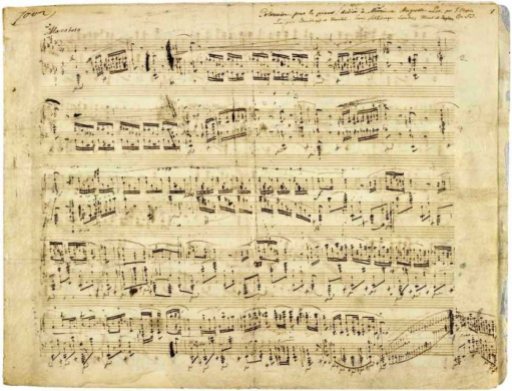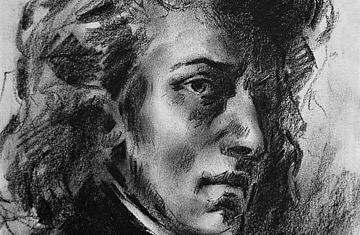Piano Teacher
Virtuosity & Piano Artistry

In the sphere of piano performance or piano artistry there are few human activities where the necessity for extraordinary physical prowess is so closely aligned with the greatest intellectual and emotional capacities.
The virtuoso must possess a memory capable of maintaining thousands of pages of music in the mind and fingers, under the stress and distractions of public performance; the virtuoso must be cultured and self-aware, musically able to convey the great range of meaning embodied within a chosen repertoire; the virtuoso must project both physical excitement and emotional communication; and the virtuoso must experience life to the fullest while remaining cloistered with an instrument in a relentless quest to maintain his or her craft at its highest level.
http://www.theartofpianoperformance.com/
Attributes & Depth Required to Interpret Chopin
A capricious, even morbid, temperament is demanded, and there must be the fire that kindles and the power that menaces; a fluctuating, wavering rhythm yet a rhythmic sense of excessive rectitude; a sensuous touch, yet a touch that contains an infinity of coloring; supreme musicianship-Chopin was a musician first, poet afterwards; a big nature overflowing with milk and honey; and, last of all, you must have suffered the tribulations of life and love, until the nerves are whittled away to a thin sensitive edge and the soul is aflame with the joy of death’ James Huneker
Are Pianists the Super-Athletes of the World?

Learning Strategies for Musical Success

Physiologist Homer Smith cites skilled piano playing as one of the pinnacles of human achievement because of the “demanding muscle coordination of the fingers, which require a precise execution of fast and complex physical movements”. This remarkable human ability provides an insight into the power of the brain. Consider Frédéric Chopin’s popular but challenging Fantaisie-Impromptu. This work requires playing approximately nineteen notes per second. The performer must learn these notes to such an extent that conscious attention to them is virtually no longer necessary. This is the aim of any playing of music—to render the technical demand to an almost unconscious level. Daniel Levitin says, “Plain old memorization is what musicians do when they learn the muscle movements in order to play a particular piece”. Much of this repetitive practice routine is more or less an algorithmic task. There’s nothing particularly creative about learning the motor mechanics of a phrase…
View original post 308 more words
Toccata BWV 915 by Johann Sebastian Bach
Toccata BWV 915
The toccata an extensive piece intended primarily as a display of manual dexterity written for keyboard instruments reached its apex with Johann Sebastian Bach in the eighteenth century. Johann Sebastian Bach’s seven Toccatas incorporate rapid runs and arpeggios alternating with chordal passages, slow adagios and at least one or sometimes two fugues. The Toccatas have an improvisational feel to them analogous to the fantasia. Unlike the Well Tempered Clavier, English suites, French suites and other sets, Bach himself did not arrange them into a collection. When JS Bach left Weimar the Toccata at that time was out of fashion. They became in vogue again after his death and were organized into a collection. The g minor Toccata is one of the more obscure of the toccatas and has rarely been performed partially due to the extensive second fugue with its many thorny passages of the contrasting gigue rhythm. However, this Toccata has many fascinating effects. It is one of the only pieces by JS Bach that has dynamic markings of piano and forte.
The g minor Toccata opens with a flourish, which leads into an expressive adagio with an improvisational feel. The adagio is interrupted by a lively allegro in the relative major key of Bb which includes concerto-ritornello passages of imitation and solo/tutti passages. A deceptive cadence leads back into the adagio where it was interrupted and then closes the adagio with a perfect authentic cadence in Bb major. This aspect provides a unity to the different movements of the Toccata. The other striking example of unity between movements is the beginning flourish repeated at the end of the second fugue, which leads into a formal closing of the work.
The extended fugue in a gigue has a subject of an ascending sequence combined with a countersubject of driving triplets. The subject of the fugue has twelve expository entries followed by eleven entries. There are inversions, permutations, combinations of minor with major, which is varied by modulating to the subdominant, then to Eb major and then back to the g minor tonic. The vivacious counter subject of driving triplets provides a symmetrical balance.
To learn more about Fugues please read my other Hub: The Art of Fugue
http://jamilasahar.hubpages.com/hub/The-Art-of-Fugue
For More Information on Piano Lessons in Boca Raton or Via Skype:
Piano Lessons in Boca Raton


Chopin’s Musical Biography
Chopin Opus 35, A Musical Biography
Chopin’s Musical Biography & Mastery of Large-Scale Form
Chopin composed a Marché in 1837, stark and unadorned in melody but quite powerful. Opus 35 is built around this Marché and is the foundation of the sonata. Two years after the Marché was written as it was originally called, the sonata became published 1839. The outline of the sonata is:
I Grave/Doppio Movimento
II Scherzo
III Marche funèbre
IV Finale
Beethoven’s Sonata no. 12 op 26 is often thought of as an influence to Chopin’s opus 35. It has a similar construction; the first movement is a theme and variation. The second movement a scherzo, the third movement a funeral march and the fourth movement is a finale of unrelenting sixteenth notes. It is known Chopin played and admired it. Additionally he used it a great deal in his teaching. Many of his students reported working on it. Chopin’s earlier attempt at the sonata was in 1829 with his first sonata in c minor. Haslinger the publisher agreed to publish it in 1829 but later changed his mind. With Chopin’s works now being in demand, Haslinger had it engraved to begin publication. Chopin refused to authorize its publication but learned it was already in distribution in a letter from his father. He had recently made his home in Paris, following an unsuccessful stay in Vienna. Beethoven’s presence was still larger than life in Vienna as master of the sonata form, and Chopin wanted to prove he too had mastery of the large-scale form. He did not want to be judged by a composition written while he was still a student.
Chopin gave a preview performance of the Marché and reviews of this performance state Chopin had a ghostly appearance. The solemn feeling of the Marché brought tears to the eyes of the audience and Chopin removing the word funèbre from the title of the Marché intensified the music’s painful impact.
Marquis de Custine, left the most evocative corroboration in a letter of 22 October 1838 to Sophie Gay:
‘Consumption has seized that figure and has made of it a soul without a body. To say his farewells to us…then, to finish, funeral marches that, despite myself, made me dissolve in tears’.
Opus 35 is structured as a narrative, a story where each of the movements leads directly into the next. The stormy agitated chords of the coda in the first movement become the theme of the scherzo.
The four bar introduction to the first movement marked grave could just as easily be an introduction to the Marché. The finale which is a miniature sonata in and of itself sums it all up in one of the most mystifying enigmatic pieces ever written for the piano in a minute and a half.
The exposition in the first movement depicts a stormy life of a Polish émigré going first to Vienna then onwards to Paris, France. The turbulence and agitation of the first theme group in the exposition exhibits Chopin’s inner turmoil, which is strongly contrasted with a lyrical second theme group in the exposition. The sarcastic side of Chopin’s personality is shown in the Scherzo. The scherzo is fiery and displays a great deal of rage with explosive chords, which emulate the repeated tonic note as in the Marché. In Chopin’s life there was also a great deal of unrest over political problems in Poland as well as a tumultuous relationship with George Sand. Another source of controversy was his opposition to the romantic climate in which he was immersed in Paris. An ingenious composer with strong roots in classical and baroque music, Chopin’s music was also revolutionary. Lyrical trios in the second and third movements follow the classical sonata outline going to the relative major keys yet still have Chopin’s distinctive nocturne style. This put his signature on the classical sonata form. Chopin’s frail health continued to deteriorate and he was often consumed with thoughts of death, hence the foundation of the sonata is the Marché. Friends said he often stated “please make sure I am not buried alive”.

Chopin establishes mastery of large-scale composition (sonata form) with his own signature style in his only composition without dedication. Chopin’s contribution to the sonata form development is substantial in opus 35. As the sonata form developed from the Baroque period of pieces with multiple movements each with their own character this developed into the sonata form of the classical period, Beethoven first expanded the form than began to compress the form and link the movements together motivicaly. Opus 35 continues the development of the sonata form with creative mastery and development of motives, which penetrate each other and are linked together.











